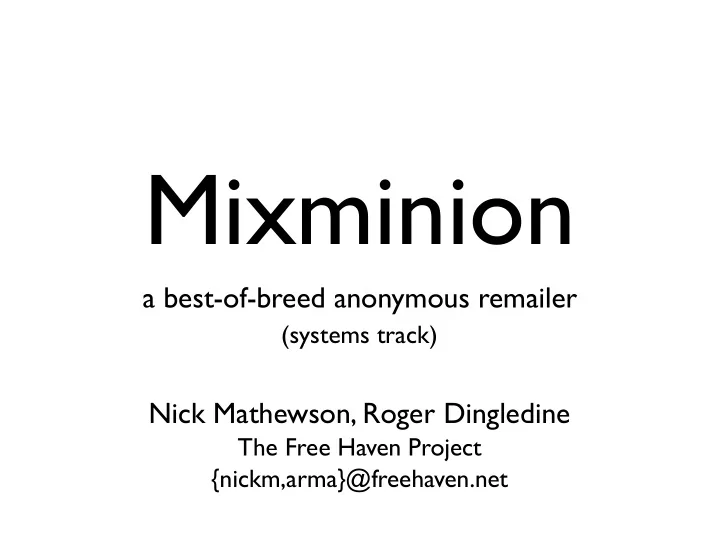

Mixminion a best-of-breed anonymous remailer (systems track) Nick Mathewson, Roger Dingledine The Free Haven Project {nickm,arma}@freehaven.net
Scope • Introduction to anonymity • How we got started • Introduction to mix-nets • Contributions • Lessons learned • Future work
Anonymity: The idea Untraceability: hide connection between senders and recipients. Unlinkability: hide connection between actions by the same sender. A.K.A. Relationship privacy, traffic-analysis resistance, “security” Sender vs Recipient anonymity high-latency vs low-latency systems
Who needs it? • Private citizens (advocacy, counseling, whistleblowing, reporting, ...) • Higher-level protocols (voting, e-cash, auctions) • Government applications (research, law enforcement) • Business applications (hide relationships and volumes of communication) • Is the CEO talking to a buyout partner? • Who are your suppliers and customers? • Which groups are talking to patent lawyers? • Who is visiting job sites?
Project origins • Let’s try implementing our research! • Why not use deployed mix-networks? • State of deployed mix-networks: bad! (2001) Two incompatible systems, no full specification, known flaws, ugly code. • The Mixminion project • Designs (2003) , specifications (2003) , software (ongoing)
Mixminion’s goals • Resolve flaws of earlier deployed remailers. • Conservative design (minimize new design work needed) • Support testing of future research • Design for deployment; deploy for use.
Motivation: The importance of adoption Anonymity systems rely on network effects more than do other cryptographic systems: • No users, no anonymity. • “Safer in the coach seats than riding first class.” (?) • Can’t assume a userbase of cryptographers
Consequences • Software required only for anonymous users: must support clear-text delivery • Must subsume function of earlier systems • Must work in real-world internet (unsynchronized, unreliable) • Entire system must be designed, specified
Consequences: Threat model (Choose for reality, not for security proofs.) • Global observer: can see all net traffic • Runs a fraction of the servers on the network • Can generate or delay traffic Weak attackers are stopped; Strong attackers are only delayed.
Deployed remailer systems Penet-style Chaum 1981 cypherpunk (type I) 1992 Later Mixmaster (type II) anonymity 1995 research “improved” cpunk Mixminion (type III) 2003
Direct Remailer M Bob,M Remailer Bob Alice example: anon.penet.fi
Add Encryption M AliceE Remailer (Bob,M) Remailer Bob
Batch and re-order Bob M Carol Alice E Mix (Bob,M) Dave Mix Ellen Fred (Chaum, 1981)
Mix-nets M4 M2 E M2 (M3,E M3 (Bob,Msg)) E M3 (Bob,Msg) Alice Msg M3 M1 E M1 (M2,E M2 (M3,E M3 (Bob,Msg))) Bob (Chaum, 1981)
Flaws of earlier systems (I) Mixmaster (type II) • Out-of-band ad hoc directories; users partitionable by directory choice. • Optional link encryption • Bad code and partial spec (but not any more) • No recipient anonymity: nym users fall back on cpunk
Flaws of earlier systems (II) “Cypherpunk” (type I) All the problems of Mixmaster, plus... • Non-uniform message length • Distinguishable user options • Vulnerable to replay attacks • Reply blocks vulnerable to flooding attacks • Batching and delaying are optional And so much, much more
Why are replies hard? Seemingly: • Forward messages need integrity checking on routing and payload at each hop • Replies can’t have integrity checking on payload at each hop Must forward and reply messages be distinguishable?
Contributions (I) • Secure reply blocks • Single-use, replay-proof • Replies indistinguishable from fwd messages except at recipient solution: use the LIONESS large-block SPRP construction to ensure that modified data is completely unrecoverable; use two headers with hashes for each; do a Feistel-like step when exchanging headers.
Contributions (II) • Integrated directory service • Enables key rotation (takes months with older systems) • Specified, extensible discovery of server capabilities and reliability • Coordinate multiple directories
Contributions (III) • Uniform forward-secure message transfer protocol. • Simple dummy-traffic policy
Status • First release: Dec 2002 • First usable release: Jan 2003 • Design published, specification online • Implementation in progress (35 kloc) • Now: 29 servers; 12 exits. (each handles ~400 packets per day; most are pings.)
Lessons (I) • Implementation can drive research: • uncovers specification gaps (reply recognition) • suggests new design problems (directory agreement problem) • exposes potential security holes (retry timing)
Lessons (II) • Theoretical security is not the whole story • With carefully defined transport, network, users, and attackers, we can win in theory... • but to win in practice, we must frustrate a real adversary in the real world, even if they would win eventually in theory.
Future work • • Usability and clients • Directory coordination • DOS limitation • Pseudonym service
For more information, see Mixminion design paper Mixminion: Design of a Type III Anonymous Remailer Protocol (Danezis, Dingledine and Mathewson, 2003)
What about Spam? • High-latency mix nets are bad for Spam • Comparatively high CPU requirements • Latency variability makes blocking easy • Still need to receive funds nymously • The real problem is abuse • Only one msg needed to annoy a newsgroup • Block at users request • Support for automatic blocking
Recommend
More recommend